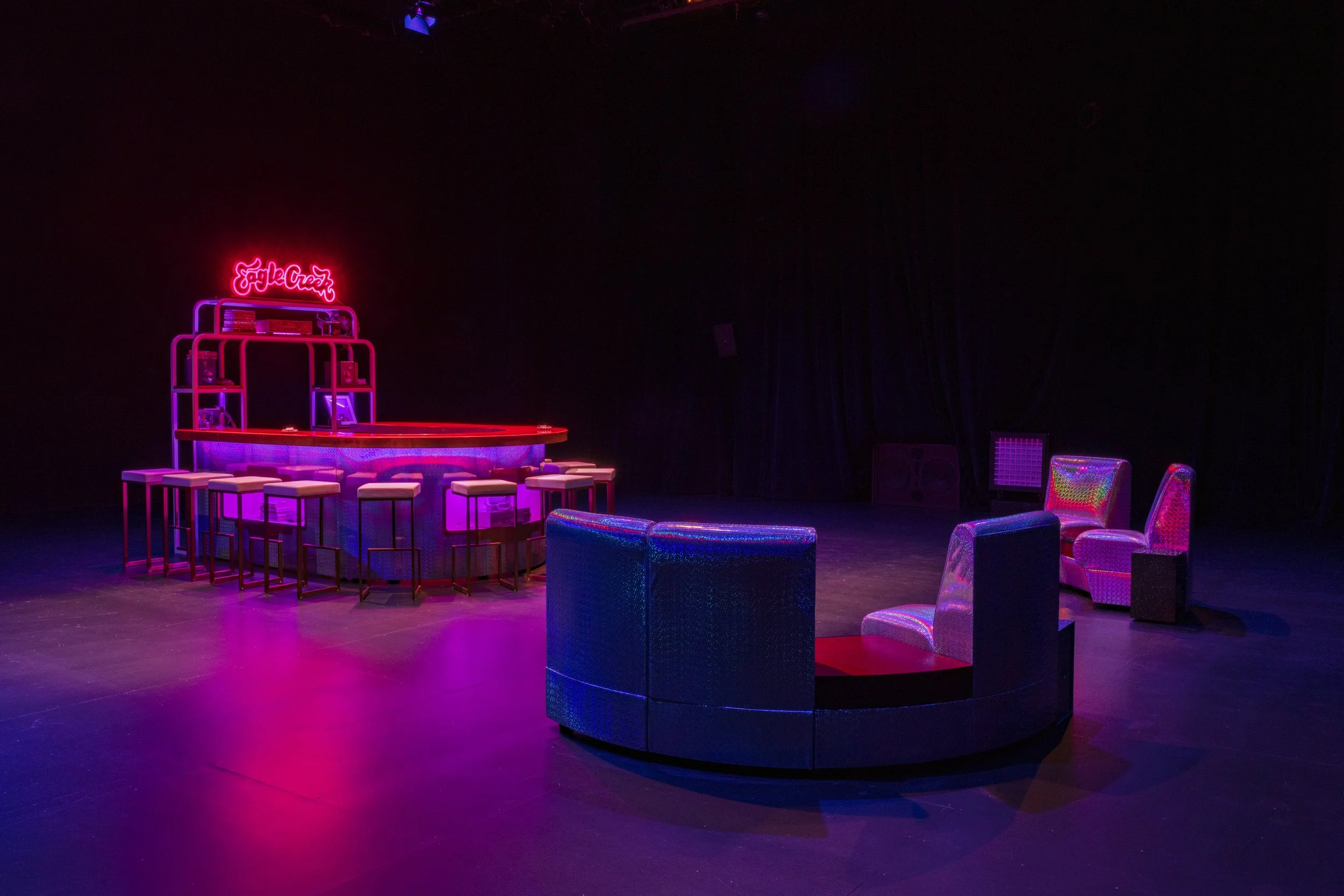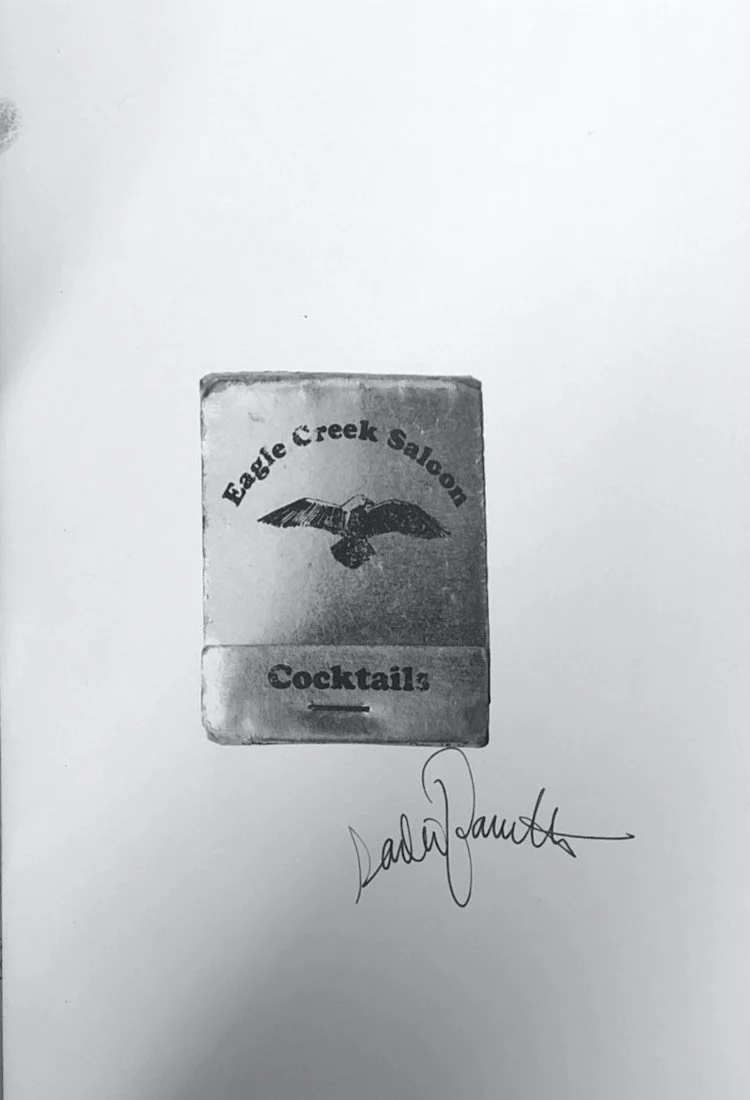An Evening of “Firsts”
By Pamela Martinez-Ibarra, Spring 2022 Curatorial Intern
“Kitchen Memories” is a series of first-hand reflections on past programming. Spotlighting a diverse range of perspectives from our community—including those of current and former staff members and artists—these posts reveal the ways that The Kitchen’s events, performances, and exhibitions have informed these individuals’ work and thinking.
I DON’T KNOW HOW MANY TIMES in my life I’ll get to see two people grow their ideas independently and then come together as seamlessly as Sadie Barnette and madison moore during their overlapping projects at The Kitchen: Barnette’s exhibition The New Eagle Creek Saloon and moore’s residency Nightlife-in-Residence.
The night of February 5th was the result of and resulted in many firsts for me. As part of my internship, The Kitchen had offered me the opportunity to attend Saturday Session 2: Nita Aviance, which was one of the events moore organized to be set into Barnette’s installation. I very excitedly accepted the invitation. I was living in New York for this internship, and this was my first time truly away from home and my first time being in this city.
From my understanding prior to the event, Barnette’s The New Eagle Creek Saloon was an installation piece made as a recreation of the real Eagle Creek Saloon, which was the first Black-owned gay bar in San Francisco that had been established by Barnette’s father, Rodney. I understood that the artist’s bar wouldn’t be an exact replica—it was more like a capturing of the original establishment’s dream as realized by a loved one. moore simultaneously would respond to Barnette’s installation by curating DJ sets as a part of their nightlife and club culture focused residency (a type of program that for The Kitchen was a first as well).
The Kitchen provided a space, a high-ceilinged black box theater, that held three bright things that evening. Starting from the back, in the corner, an improvised dressing room that existed as a shiny standing mirror, a couch in a bright color my brain couldn’t quite process, and two simple racks that bowed under the weight of complex outfits. Over this area hung what appeared to be large portraits rendered in black paint on newsprint sheets. In the very center of the room stood a bar lined with empty chairs, glittery gray bathed in its own deep pink neons. The counter was eaten up completely by technology responsible for set after set of club beats that owned the audience’s sense of hearing. All this would have been enough on its own, but what made the experience visually impressive and exciting to me was the way people filled the space.
MY EXPERIENCE WITH ART prior to my internship at The Kitchen has been quite limited, to say the least. Turns out, they don’t have much in the way of art museums where I’m from in the Middle of Nowhere, Ohio. I’d never even been to an art museum until I made it to New York City. In my mind, I had an expectation for the amount of people who would go to an art installation and the amount of people who would be at a gay bar. I struggled to imagine what a combination of both might yield in terms of turnout. The handful of college art installations I’ve attended in the past have had a maximum of nine people in attendance at a time—the audience small and the event made personal. Growing up as a queer person, I’ve never had the opportunity to experience nightlife personally before, since a consistent, queer-friendly space hasn’t existed where I’ve lived most of my life. I’ve operated under the assumption that each gay bar has its own unique scene and many are usually packed wall-to-wall with people.
These assumptions did nothing to prepare me for the Saturday Session at The New Eagle Creek Saloon. No one was dressed for the same event. Patent leather next to a cardigan next to a pound of hair gel next to a blazer. The audience was no more than thirty-five people but they were doing an impression of a crowd of three hundred and pulling it off—if you didn’t look at the empty corners and sides of the room. The lighting was low and there was some seating put out near the bar for everyone to dance next to. I kept myself busy taking pictures for a while until I could force up the confidence needed to dance all by myself. One of the performers for the event began striding towards me on one of their rounds for a set. She danced with me for a second for the cameras and effortlessly hid that I wasn’t fast enough to move out of the way. First time dancing by myself, a first taste of queer nightlife, and my first dance with a drag queen.
At this point in the event, a voice cut through the space, a call to gather around the bar for a conversation. Seven people bathed in light sat in front of the audience, the soft fog bleeding away from them towards us.
The speakers were Barnette and moore; Nita Aviance, Analog Soul, and Will Automagic (the DJs who performed that day); and Kevin Aviance and Xander (two of the performers for whom the dressing room was set up). The two artists wore matching outfits by accident, moore a little shinier and Barnette looking a little sleeker. Mirroring each other enough to blend together impressively, the artists brought energy to the table that highlighted the best in what the other had to offer. You might even call it too perfect.
During this portion of the event, the audience had the chance to ask questions. I couldn’t find my voice in time. Only one person asked a question. It was something like, “how can younger generations access safe spaces and knowledge from our elders.” I grew up lonely in a conservative area. I never hid much from the public, but I have never come out to my loving, immigrant mother because I wouldn’t be able to stand it if she surprised me with a negative reaction. The communities I have had access to are small and private—confined to lunch tables and midwestern Walmart parking lots and my parent’s basement. We were all working hard for those scholarships in school to get the hell out, and with no money, queer life didn’t look like much. At my midwestern liberal arts college, the queer community is thriving, but it’s still in the context of my generation and a bunch of nerds.
At one point, Kevin Aviance said, “We are standing on shoulders tonight.” Words like that shake all the breath out of your lungs. The intensity in her voice as she spoke reduced the microphone down to a prop. Other responses addressed why the divide exists between generations in the queer community, how it is important to seek out the elders because they are still reeling from trauma, and how young queer people are doing things unimaginable to those only a generation back. I was hanging off of every word. Quoting the speakers is impossible, because their conversation touched the place inside me where words cannot exist.
After the crowd had been moved between clapping and thoughtful silence a few times, the evening closed out with our hosts playing tracks that are personally important to them. Dancing resumed, and if the energy of that could be sealed away and made available for purchase, I can’t imagine the depth of the pockets you’d have to have to be able to afford it.
I’VE BEEN LISTENING TO THE VERY LAST SONG played that day ever since, “Just Us” by Two Tons of Fun. Throughout the event, there was a family present, and I found my eyes seeking them out the whole time I was there. Two parents and a young child, all three together and dancing. I’ve been thinking of that family when I listen to this song. They stuck out so much; it looked like they were playing when they danced. I’ve never seen adults so comfortable with being that playful in public with a child. Sometimes I would catch them, the parents, looking at each other, and in those glances they exchanged the sweetest expressions of care. It was clear to me that I was watching two people invest in the way their child sees the world. Maybe I’m romanticizing strangers, but seeing that family offered me a lot of motivation to keep going. What would it mean for that child to grow up in these harrowing times with a memory like that? To grow up with a positive association for a subculture that often has been disregarded and labeled an inappropriate topic of conversation. I hope that family talked about the night at The New Eagle Creek Saloon all the way home, and I hope the kid asked questions, and I hope the parents had good answers and didn’t hesitate with him. I hope he had dreams full of neon colors and dancing and pretty swirling clouds. I hope he remembers that night the way I do, and if he ever hears “Just Us” it’ll remind him what it was like to be at The New Eagle Creek Saloon.
Images: 1) Sadie Barnette: The New Eagle Creek Saloon, 2022. Installation view at The Kitchen, January 18–March 6, 2022. Photo: Adam Reich. 2) Kevin Aviance in madison moore: Nightlife-in-Residence, Saturday Session 2: Nita Aviance, February 5, 2022. Performance view, The Kitchen. Photo ©2022 Paula Court. 3) Analog Soul, Xander, Nita Aviance, madison moore, Sadie Barnette, Kevin Aviance, and Will Automagic in madison moore: Nightlife-in-Residence, Saturday Session 2: Nita Aviance, February 5, 2022. Performance view, The Kitchen. Photo ©2022 Paula Court. 4) Left and right: Signed pages of Sadie Barnette, “Eagle Creek Saloon Zine,” 2022. To see the full zine, click here. Signatures collected by Pamela Martinez-Ibarra from artists participating in madison moore: Nightlife-in-Residence, Saturday Session 2: Nita Aviance, February 5, 2022.





